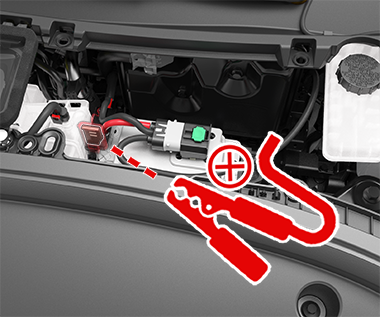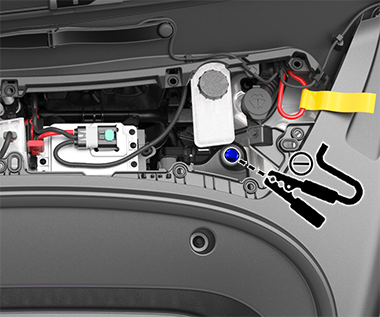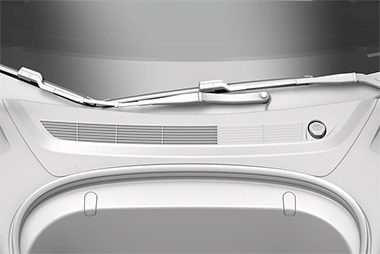Jump Starting
The procedure for jump starting differs depending on whether the low voltage battery is lead-acid or lithium-ion. To determine which battery your vehicle uses, touch . Both procedures are provided in this section.
The following instructions assume you are using an external low voltage power supply (such as a portable jump starter). If jump starting Model 3 using another vehicle, refer to the vehicle manufacturer's instructions.
Jump Starting the Low Voltage (Lead-Acid) Battery
Vehicles manufactured in Gigafactory Shanghai before approximately October 2021, and in the Fremont Factory before approximately December 2021, are equipped with a Lead-Acid low voltage battery.
If jump starting Model 3 using another vehicle, refer to that vehicle manufacturer's instructions. The following instructions assume you are using an external low voltage power supply (such as a portable jump starter).
- Open the hood (see Opening the Hood with No Power).
- Remove the maintenance panel by pulling it upwards to release the trim clips that hold it in place.
- Remove the cabin intake trim panel by pulling it upwards to release the trim clips that hold it in place.
- Connect the low
voltage power supply's red positive (+) cable to the red positive (+) terminal on the low
voltage battery.CAUTIONTo avoid damaging Model 3, do not allow the positive cable to contact other metal components, such as the battery tie-down bracket.
- Connect the low voltage power supply's black negative (-) cable to the black negative (-) terminal on the low voltage battery.
- Turn on the external power supply (refer to the manufacturer’s instructions). Touch the touchscreen to wake it up.NoteIt may take several minutes to receive enough power to wake up the touchscreen.
- When external low voltage power is no longer required, disconnect both cables from the terminals on the battery, beginning with the black negative (-) cable.
- Reinstall the cabin intake trim panel by placing it back in its original location and pressing down until it is secure.
- Replace the maintenance panel by placing it back in its original location and pressing down until it is secure.
- Close the hood.
Jump Starting the Low Voltage (Lithium-Ion) Battery
Vehicles manufactured in Gigafactory Shanghai after approximately October 2021, and in the Fremont Factory after approximately December 2021, are equipped with a Lithium-Ion low voltage battery.
- Open the hood (see Opening the Hood with No Power).
- Remove the maintenance panel by pulling it upwards to release the trim clips that hold it in place.
- Remove the red cover and connect the external low voltage power supply’s red positive (+) cable to the red positive (+) jump post. CAUTIONTo avoid damaging the vehicle, do not allow the positive cable to contact other metal components.

- Connect the external low voltage power supply’s black negative (-) cable to the bolt located between the brake fluid reservoir and the front trunk. The bolt is used as a grounding location for the external support.

- Turn on the external power supply (refer to the manufacturer’s instructions) for 20 seconds only, then switch off or disconnect the power supply. CAUTIONIf you leave the power supply on for longer than 20 seconds, the low voltage battery may not self-recover and the vehicle might not be able to shift into Drive. If this occurs, after disconnecting the power supply, disconnect the low voltage battery, then reconnect the low voltage battery to enable another battery self-recovery attempt.NoteIf attempting to activate Transport Mode (to winch the vehicle onto a flatbed truck), the low voltage battery is not required to self-recover. Leave the power supply connected continuously until the vehicle has been secured.
- Open the driver door and wait two minutes.
- Ensure the vehicle is able to shift into Drive.
- Replace the maintenance panel by placing it back in its original location and pressing down until it is secure.
- Close the hood.
